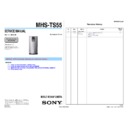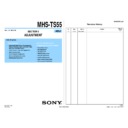Read Sony MHS-TS55 Service Manual online
MHS-TS55
Sony Corporation
SERVICE MANUAL
Revision History
SERVICE NOTE (Check the following note before the service.)
983462512.pdf
Ver. 1.1 2012.04
MOBILE HD SNAP CAMERA
The components identified
by mark
by mark
0 or dotted line with
mark
0 are critical for safety.
Replace only with part number
specified.
specified.
Les composants identifiés par
une marque
une marque
0 sont critiques
pour la sécurité.
Ne les remplacer que par une
pièce portant le numéro spécifié.
Ne les remplacer que par une
pièce portant le numéro spécifié.
Worldwide Model
1-1. NOTE AFTER REPAIRING / INSPECTING
1-2. NOTE ON MAIN BOARD ASSY REPLACEMENT
1-3. METHOD FOR COPYING OR ERASING THE DATA IN INTERNAL MEMORY
1-4. REGARDING FUSE
1-2. NOTE ON MAIN BOARD ASSY REPLACEMENT
1-3. METHOD FOR COPYING OR ERASING THE DATA IN INTERNAL MEMORY
1-4. REGARDING FUSE
9-834-625-12
MHS-TS55
Internal memory
ON BOARD
Internal memory
ON BOARD
Ver.
Date
History
Contents
S.M. Rev.
issued
1.0
2011.12
Official Release
—
—
1.1
2012.04
Revised-1
(A1 11-501)
(A1 11-501)
• Correction of REPAIR PARTS LIST
Page
Page
2-1
,
2-3
,
2-4
• Correction of ASSEMBLY
Page
Page
3-1
Yes
2012D08-1
© 2012.04
Published by Sony Techno Create Corporation
– ENGLISH –
Revised-1
Replace the previously issued
SERVICE MANUAL 9-834-625-11
with this Manual.
SERVICE MANUAL 9-834-625-11
with this Manual.
MHS-TS55
– 2 –
Camera
[System]
Image device: 7.35 mm (1/2.5 type) CMOS sensor
Total pixel number of camera:
Total pixel number of camera:
Approx. 13.0 Megapixels
Effective pixel number of camera:
Approx. 8.3 Megapixels (still image, 16:9),
Approx. 12.8 Megapixels (still image, 4:3),
Approx. 2.1 Megapixels ([1920×1080 30p]
movie)
Lens: F2.8
Lens: F2.8
f = 5.3 mm (7/32 inches)
When converted to a 35 mm still camera
For movies: 37 mm (1 1/2 inches) (16:9)
For still images: 32 mm (1 5/16 inches) (4:3)
Exposure control: Automatic exposure
File format:
File format:
Still images: JPEG (DCF Ver. 2.0, Exif Ver.
2.3, MPF Baseline) compliant
2.3, MPF Baseline) compliant
Movies: MPEG-4 AVC/H.264 (MP4)
Audio:
MPEG
AAC
Recording media: Internal Memory (approx.
8
8
GB)
• When measuring media capacity, 1 GB equals
1 billion bytes, a portion of which is used for
system management and/or application files.
system management and/or application files.
Available user capacity is approximately 7.6
GB.
[Input and Output connectors]
HDMI OUT jack: HDMI mini connector
Built-in USB arm: type A (built-in)
USB communication: Hi-Speed USB (USB 2.0
compliant)
Built-in USB arm: type A (built-in)
USB communication: Hi-Speed USB (USB 2.0
compliant)
[LCD screen]
LCD screen: 7.6 cm (3.0 type) TFT drive
Total number of dots: 288 000 (720 × 400) dots
Total number of dots: 288 000 (720 × 400) dots
[Power, general]
Power:
Built-in rechargeable battery pack
USB
charging
Charging time: Approx. 330 mins. (when charging
from the USB connector of the computer)
Approx. 150 mins. (when charging from the
AC-UD20 USB charger (sold separately))
Power consumption (during shooting): 2.1 W
(when the movie image size is [1280×720
30p])
30p])
Wireless LAN: OFF
Operating temperature: 0°C to 40°C (32°F to
104°F)
Storage temperature: –20°C to +60°C (–4°F
to +140°F)
to +140°F)
Dimensions: Approx. 54.8 mm × 113.0 mm ×
15.5 mm (2 1/4 inches × 4 1/2 inches ×
5/8 inches) (W/H/D)
Mass: Approx. 137 g (4.8 oz)
Microphone: Stereo
Speaker: Monaural
Microphone: Stereo
Speaker: Monaural
[Wireless LAN]
Standards: IEEE802.11b/g/n compliant
Design and specifications are subject to change
without notice.
without notice.
SPECIFICATIONS
SAFETY-RELATED COMPONENT WARNING!!
COMPONENTS IDENTIFIED BY MARK 0 OR DOTTED LINE WITH
MARK 0 ON THE SCHEMATIC DIAGRAMS AND IN THE PARTS LIST
ARE CRITICAL TO SAFE OPERATION. REPLACE THESE COMPO-
NENTS WITH SONY PARTS WHOSE PART NUMBERS APPEAR AS
SHOWN IN THIS MANUAL OR IN SUPPLEMENTS PUBLISHED BY
SONY.
MARK 0 ON THE SCHEMATIC DIAGRAMS AND IN THE PARTS LIST
ARE CRITICAL TO SAFE OPERATION. REPLACE THESE COMPO-
NENTS WITH SONY PARTS WHOSE PART NUMBERS APPEAR AS
SHOWN IN THIS MANUAL OR IN SUPPLEMENTS PUBLISHED BY
SONY.
ATTENTION AU COMPOSANT AYANT RAPPORT
À LA SÉCURITÉ!
LES COMPOSANTS IDENTIFIÉS PAR UNE MARQUE 0 SUR LES
DIAGRAMMES SCHÉMATIQUES ET LA LISTE DES PIÈCES SONT
CRITIQUES POUR LA SÉCURITÉ DE FONCTIONNEMENT. NE REM-
PLACER CES COMPOSANTS QUE PAR DES PIÈCES SONY DONT
LES NUMÉROS SONT DONNÉS DANS CE MANUEL OU DANS LES
SUPPLÉMENTS PUBLIÉS PAR SONY.
DIAGRAMMES SCHÉMATIQUES ET LA LISTE DES PIÈCES SONT
CRITIQUES POUR LA SÉCURITÉ DE FONCTIONNEMENT. NE REM-
PLACER CES COMPOSANTS QUE PAR DES PIÈCES SONY DONT
LES NUMÉROS SONT DONNÉS DANS CE MANUEL OU DANS LES
SUPPLÉMENTS PUBLIÉS PAR SONY.
SAFETY CHECK-OUT
After correcting the original service problem, perform the following
safety checks before releasing the set to the customer.
safety checks before releasing the set to the customer.
Caution
Danger of explosion if battery is incorrectly replaced.
Replace only with the same or equivalent type.
Dispose of used batteries according to the instructions.
Replace only with the same or equivalent type.
Dispose of used batteries according to the instructions.
1. Check the area of your repair for unsoldered or poorly-soldered
connections. Check the entire board surface for solder splashes and
bridges.
bridges.
2. Check the interboard wiring to ensure that no wires are “pinched”
or contact high-wattage resistors.
3. Look for unauthorized replacement parts, particularly transistors,
that were installed during a previous repair. Point them out to the
customer and recommend their replacement.
customer and recommend their replacement.
4. Look for parts which, through functioning, show obvious signs of
deterioration. Point them out to the customer and recommend their
replacement.
replacement.
5. Check the B+ voltage to see it is at the values specified.
6. Flexible Circuit Board Repairing
6. Flexible Circuit Board Repairing
• Keep the temperature of the soldering iron around 350°C during
repairing.
• Do not touch the soldering iron on the same conductor of the circuit
board (within 3 times).
• Be careful not to apply force on the conductor when soldering or
unsoldering.
UNLEADED SOLDER
This unit uses unleaded solder.
Boards requiring use of unleaded solder are printed with the lead free
mark (LF) indicating the solder contains no lead.
(Caution: Some printed circuit boards may not come printed with the
Boards requiring use of unleaded solder are printed with the lead free
mark (LF) indicating the solder contains no lead.
(Caution: Some printed circuit boards may not come printed with the
lead free mark due to their particular size.)
: LEAD FREE MARK
Be careful to the following points to solder or unsolder.
• Set the soldering iron tip temperature to 350°C approximately.
If cannot control temperature, solder/unsolder at high temperature
for a short time.
for a short time.
Caution: The printed pattern (copper foil) may peel away if the
heated tip is applied for too long, so be careful!
Unleaded solder is more viscous (sticky, less prone to
flow) than ordinary solder so use caution not to let solder
bridges occur such as on IC pins, etc.
flow) than ordinary solder so use caution not to let solder
bridges occur such as on IC pins, etc.
• Be sure to control soldering iron tips used for unleaded solder and
those for leaded solder so they are managed separately. Mixing un-
leaded solder and leaded solder will cause detachment phenomenon.
leaded solder and leaded solder will cause detachment phenomenon.
MHS-TS55
1-1
1. SERVICE NOTE
1-1. NOTE AFTER REPAIRING / INSPECTING
After repairing or inspecting with this model, perform [Initialize] and [Format] to erase the history of access to Web.
When performing [Initialize] and [Format], the customer’s setups are also reset.
Therefore, when returning the repaired unit, print “Flyer” at the end of this volume and attach it to the unit.
For [Initialize], refer to the procedure below.
For [Format], refer to “1-3. METHOD FOR COPYING OR ERASING THE DATA IN INTERNAL MEMORY”.
When performing [Initialize] and [Format], the customer’s setups are also reset.
Therefore, when returning the repaired unit, print “Flyer” at the end of this volume and attach it to the unit.
For [Initialize], refer to the procedure below.
For [Format], refer to “1-3. METHOD FOR COPYING OR ERASING THE DATA IN INTERNAL MEMORY”.
Initialize
Initializes the setting to the default setting.
Even if you execute this function, the images are retained.
Even if you execute this function, the images are retained.
1 Tap [MENU]
t [Main Settings] t [Initialize] t
[OK].
• Perform initialization after charging the camera to prevent the camera from turning off during the
process.
• The following Wi-Fi connection settings are also initialized:
– Login information for each network service
– Wi-Fi access point information
– Wi-Fi access point information
Note
1-2. NOTE ON MAIN BOARD ASSY REPLACEMENT
In case of replacing the MAIN BOARD ASSY, it is necessary to erase the customer’s network setup data and login information data from the board
to be replaced.
Thus, before replacing the board, perform [Initialize] and [Format].
For [Initialize], refer to “1-1. Note after repairing / inspecting”.
For [Format], refer to “1-3. METHOD FOR COPYING OR ERASING THE DATA IN INTERNAL MEMORY”.
to be replaced.
Thus, before replacing the board, perform [Initialize] and [Format].
For [Initialize], refer to “1-1. Note after repairing / inspecting”.
For [Format], refer to “1-3. METHOD FOR COPYING OR ERASING THE DATA IN INTERNAL MEMORY”.
When replacing with a MAIN BOARD ASSY, implement the work below.
• Perform the adjustments and Set Language Destination, referring to ADJUSTMENT Service Manual.
• Search the access point as concise operation confirmation of wireless LAN.
• Print “Flyer” at the end of this volume and attach it to the repaired unit.
• Perform the adjustments and Set Language Destination, referring to ADJUSTMENT Service Manual.
• Search the access point as concise operation confirmation of wireless LAN.
• Print “Flyer” at the end of this volume and attach it to the repaired unit.
(Because the MAC address of the board is changed when the MAIN BOARD ASSY is replaced.)
1-3. METHOD FOR COPYING OR ERASING THE DATA IN INTERNAL MEMORY
The data can be copying/erased by the operations on the Setup screen. (When erasing the data, execute formatting the internal memory.)
Note1: When replacing Main Board Assy, erase the data in internal memory of the board before replacement.
Note2: When replacing Main Board Assy, execute formatting and initialize the internal memory after replacement.
Note2: When replacing Main Board Assy, execute formatting and initialize the internal memory after replacement.
Method for Copying the Data in Internal Memory
Copying images to a smartphone
(View on Smartphone)
(View on Smartphone)
You can copy recorded images to a smartphone or tablet computer. Installing a suitable
application (“PlayMemories Mobile”) for this purpose to the smartphone or tablet computer is
required in advance.
application (“PlayMemories Mobile”) for this purpose to the smartphone or tablet computer is
required in advance.
1 Tap [MENU]
t [View on Smartphone].
2 Tap [View password] and perform Wi-Fi setting on the smartphone, using
the [SSID] and the [Password] shown.
3 Select and transfer the camera contents using the installed application on
the smartphone.
Method for Formatting the Internal Memory
Format
Formats the internal memory.
1 Tap [MENU]
t [Main Settings] t [Format] t
[OK].
• Note that formatting permanently erases all data.
Note
MHS-TS55
1-2E
1-4. REGARDING FUSE
• MAIN BOARD
F1
Not supplied
FUSE SMD0805P035TF (0.35A/6V)
Not supplied
FUSE SMD0805P035TF (0.35A/6V)
Ref.No:
Part No:
Description:
Part No:
Description:
F5
1-523-079-11
(2A/36V)
1-523-079-11
(2A/36V)
Ref.No:
Part No:
Description:
Part No:
Description:
F2
1-523-079-11
(2A/36V)
1-523-079-11
(2A/36V)
Ref.No:
Part No:
Description:
Part No:
Description:


